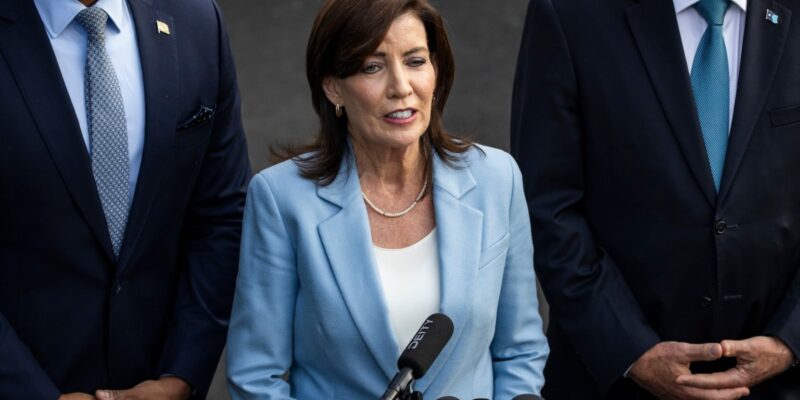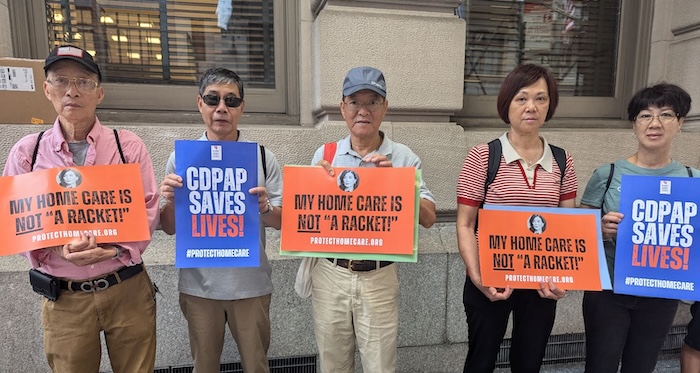
In late April, New York Democratic Gov. Kathy Hochul and state lawmakers finalized a $233 billion budget for the next fiscal year. One item in its 144-page official summary has sparked fear among disability advocates: dramatic changes to a vital home health aid program that may push more people into nursing homes.
A quarter of a million New Yorkers currently use CDPAP, a widely popular program launched in 1995, which facilitates Medicaid funding for home carers chosen by patients themselves at hours they arrange. Participants spoke to Mother Jones about how the program allows them to remain in their communities, rather than being institutionalized—a cause central to disability rights activism. Without access to workers who understand their needs, like assisting people with spinal cord injuries with toileting, those participants risk hospitalization, placement in restrictive long-term care, or both.
The program is run through “fiscal intermediaries,” which provide financial and administrative oversight; some specialize in helping certain groups, such as the Bengali immigrant community. Hochul’s plan would make the program an administrative monopoly: by October, one middleman—potentially an out-of-state, for-profit firm—will hold a $40 billion contract covering all 250,000 participants in the state. Currently, those intermediaries are subject to oversight by New York’s chief fiscal officer; under Hochul’s system, the new middleman wouldn’t be. In late July, some current intermediaries sued New York’s Department of Health over the changes.
Hochul has been incredibly critical of CDPAP, calling it a “racket.”
“This was a backroom deal that happened days before the budget was finalized,” said Kendra Scalia, a disabled public policy analyst and board president of the Consumer Directed Personal Assistance Association of New York State, which supports both CDPAP providers and recipients. “It was never discussed with disabled communities.”
Hochul has been incredibly critical of CDPAP, calling it a “racket” and “one of the most abused programs in the entire history of the state of New York.” But 2022 audits by the state’s Medicaid Inspector General reviewed $37 million in claims—and found that 99 percent were accurate. Of $46,000 in documented overpayments, $41,000 was recollected. Hochul’s office did not respond to a request for evidence that the program has been abused.

It can already be difficult to get care through CDPAP. For Laura Mauldin, a graduate student when she applied in 2010, it took nine months—and an initial rejection—to get her partner, who had been sick with cancer for four years, approved for support.
“There was not an option to check for CDPAP” in home care applications at the time, said Mauldin. The request for around-the-clock care was eventually approved—allowing Mauldin to leave her apartment, with her partner in a worker’s care—but so late that Mauldin’s partner was only able to use it for three months before passing away.
Critics like Hochul see the potential for corruption in the fact that disabled people can hire family members—something Kendra Scalia first did by hiring her sister when she was in college.
“I felt really vulnerable to hiring strangers or welcoming strangers into my dorm room where there’s no oversight,” Scalia said. Her brother now has worked as her assistant for the past decade.
Some care workers feel they’ve been left in limbo on how Hochul’s changes will impact them. For the past 25 years, Tara Murphy has worked as a home care provider through CDPAP, after working as a certified nursing assistant in a nursing home. As a home carer, Murphy felt she’d be able to serve people better.
“I saw all the horrendous things and lack of care and neglect that were happening,” said Murphy, who is based in Troy, New York. “I knew I couldn’t change it, and I didn’t want to be part of the medical mafia.”
Now, Murphy is panicked over the impending changes to the program that helps employ her. She doesn’t know whether she’d be hired under the new monopoly, or whether her pay will be cut. “I’m sitting here every day,” Murphy said, “like, ‘Am I going to have a place to live? Am I going to be able to eat?’
1199SEIU, New York’s main health care workers’ union, has been critical of for-profits’ growing role in the program. Helen Schaub, the union’s interim political director, said that administrative costs have ballooned since a 2012 jump in the number of for-profit intermediaries. One of New York’s largest home care intermediaries, Schaub points out, is being run by embattled insurance giant Anthem.
Some users of the program who spoke with Mother Jones also expressed concerns that pay cuts could force their aides to look elsewhere for work, leaving both patients and workers in a difficult position.
Lacey Tompkins, who works in advertising in New York City, says that CDPAP makes it possible for her to maintain a partly remote job as a disabled worker, with help getting to work despite hours that can change from week to week. “I can make my decisions and not [have] a standard set of hours,” Tompkins said.
Advocates with differing views agree on one thing: Hochul’s six-month timeline to transform the program is unreasonable and impractical. “Any serious company who is bidding on the work also believes that, because it’s a very daunting task,” said Schaub, of SEIU. “Privately, people in the [Hochul] administration have said, ‘We know that it can’t happen on that scale.’”
Update, August 13: This article has been updated to detail the current and proposed roles of the New York State Comptroller in reviewing the state’s CDPAP program.















